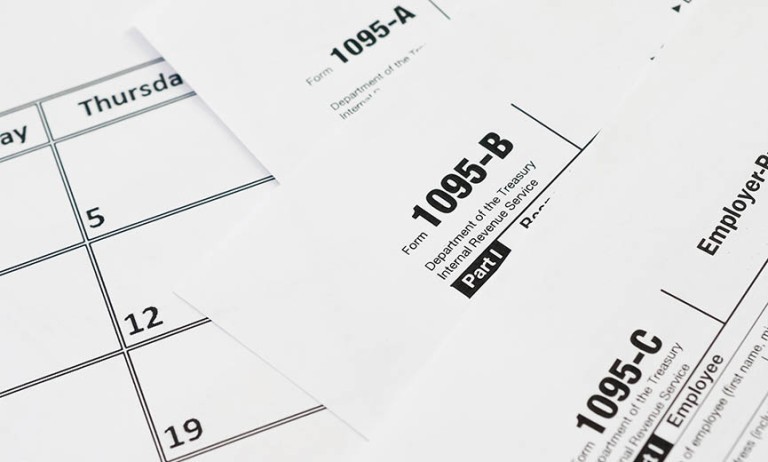- Impuestos
- Artículo
- Lectura de 6 minutos
- Last Updated: 10/25/2024
Difference Between 1095 Forms: 1095-A vs. 1095-B vs. 1095-C

Table of Contents
Employers may become overwhelmed by health insurance paperwork and reporting responsibilities. Under the Affordable Care Act (ACA), the IRS requires all applicable employers and qualified health plan providers to report information about their health plans and health coverage enrollment using tax Forms 1095 A, B, and C. However, there are different requirements for each of these documents. Learn more about the difference between 1095-A, 1095-B, and 1095-C, including who issues and files them, what information is on them, and what employers require.
What Is Form 1095-A and What Is It Used For?
The 1095-A form, also known as the Health Insurance Marketplace Statement, is for those who didn't have access to or chose not to take part in an employer-sponsored plan and instead had health insurance through the Health Insurance Marketplace (also commonly known as an exchange) in the previous year.
The form includes the total amount of premiums paid, the premium tax credits (PTC) used, and a figure referred to as the second lowest cost Silver plan (SLCSP), the second-lowest priced Marketplace plan in the Silver category. This figure is needed to determine the final premium tax credit.
Recipients use Form 1095-A to fill out Form 8962, Premium Tax Credit. This refundable credit helps cover health insurance premiums purchased through the Health Insurance Marketplace.
Who Must File 1095-A?
Individuals who had health insurance through the Health Insurance Marketplace must use the information found on Form 1095-A to complete Form 8962. Once they've completed the form, it must be filed with the individual's federal income tax return if they wish to claim a premium tax credit or have received assistance through advance payments of the premium tax credit (APTC).
Who Issues Form 1095-A?
The Marketplace is responsible for sending 1095-A forms to enrolled individuals. Employers do not have to send employees 1095-A forms. If a person who received health coverage through the Marketplace did not receive a 1095-A, they should contact the Marketplace health plan provider.
What Is Form 1095-B and What Is It Used For?
Form 1095-B, Health Coverage, is a tax form used to report certain information to the IRS (type of plan, period of coverage, and the names of dependents covered by the plan) and to individuals who are covered by the minimum essential coverage required by the Affordable Care Act.
Consumers must have 1095-B to verify on their taxes that they and their dependents had at least minimum essential coverage in the previous year.
Who Must File 1095-B?
Tax Form 1095-B is sent to taxpayers, their spouse, and their dependents if they were enrolled through a self-insured employer that is not an Applicable Large Employer (ALE) or insurance provider the previous year. Taxpayers don't need to attach Form 1095-B to their return; they should keep it with their tax records. Beginning January 1, 2019, the individual mandate penalty at the federal level for not having health coverage was reduced to zero. Still, some states implemented their own state- and district-level individual health insurance mandates with reporting requirements and associated penalties.
Self-insured small businesses must file Form 1095-B to report information on individuals provided minimum essential coverage.
Who Issues Form 1095-B?
The 1095-B form is mailed to individuals and issued by health coverage providers, which may be one of the following:
- Insurance companies outside the Marketplace
- Government agencies such as Medicare or CHIP
- Employers that provide certain kinds of health coverage (also known as "self-insured coverage") but do not have to send Form 1095-C (see below)
- Other coverage providers
What Is Form 1095-C and What Is It Used For?
Form 1095-C (Employer-Provided Health Insurance Offer and Coverage) is a tax form that documents the health insurance coverage offered and whether an employee is enrolled in it. The form must be filed and furnished to applicable employees if your business is an applicable large employer (ALE) — meaning you have, in general, an average of 50 or more full-time employees, including full-time equivalents, during the prior calendar year, regardless of whether they enrolled in the company-sponsored health plan — or your business is self-insured. ALEs must report that information for each employee for all 12 months of the calendar year.
The IRS uses information reported on Form 1095-C to determine if an employer or employee is responsible for any fines for failure to comply with the ACA.
If an employer is not an ALE, they're not required to file Form 1095-C. However, if a business is, in fact, an ALE and doesn't file these forms, the IRS can determine if it appears an employer is large enough to be an ALE. In such a case, the IRS may send out requests for missing returns and possibly issue penalties if a business doesn't respond promptly or with the proper information.
Who Must File 1095-C?
Applicable large employers must file a separate Form 1095-C for each full-time employee. Employees will use this information to complete their taxes, but they don't have to send a copy of this form to the IRS when they file. They should keep it with their tax records.
Self-insured ALEs must also file Form 1095-C to report information to the IRS and employees about individuals enrolled in coverage under the employer plan.
Employers must also file completed Form 1094-C, a summary of the aggregated 1095-C forms filed for a given calendar year. This form, sent to the IRS, includes contact information and the employer's Employer Identification Number (EIN), the contact person's name, and the total number of employees.
Forms 1094-C and 1095-C must be filed regardless of whether an ALE offers coverage or whether the employee enrolls in any coverage offered. Given how complex and time-consuming it can be to verify, catalog, and report accurate data, many businesses rely on ACA compliance and ESR reporting services to help them compile the necessary information to deliver Form 1095-C to employees and file Forms 1094-C and 1095-C with the IRS.
Who Is Required to Issue Form 1095-C?
ALEs must issue a Form 1095-C to every full-time employee, regardless of whether employees are enrolled in a company-sponsored health plan. Employers must also keep a copy of every 1095-C form to send to the IRS to fulfill ACA reporting requirements or risk possible assessments.
Make Sure You and Your Employees Understand What Forms You Need at Tax Time
The steps required to meet ACA requirements take a considerable amount of time. An integrated solution that combines benefits, payroll, and insurance data can take much of the burden off your shoulders at reporting time.
An ACA reporting service such as Paychex Employer Shared Responsibility Services can help you prepare and file complex tax forms, send completed Forms 1095-C directly to your employees, and analyze and monitor the type and affordability of your offered coverage throughout the year.*
Form 1095 FAQs
-
Why Do I Need Form 1095-A or Form 1095-C?
Why Do I Need Form 1095-A or Form 1095-C?
When comparing why an employee needs Form 1095-A vs. 1095-C, note that each form provides different information. You need the information on these forms to verify that you, your spouse, and any dependents had coverage for each month during the year.
Form 1095-A is issued by the Marketplace to individuals who have enrolled themselves or a family member in health coverage through the Marketplace. Employees need the information on the form to complete Form 8962 to reconcile any advance payments of the premium tax credit or to claim the premium tax credit.
Form 1095-C is issued by applicable large employers to individuals who either work full-time for the ALE or who work part-time if they enroll in self-insured coverage provided by the ALE. Form 1095-C shows proof that your employer offered coverage to you even if you chose not to enroll in it.
-
Can I Receive IRS Form 1095-A, Form 1095-B, and 1095-C All in One Year?
Can I Receive IRS Form 1095-A, Form 1095-B, and 1095-C All in One Year?
It's possible to receive Form 1095-A, Form 1095-B, and 1095-C in one year. If you had coverage from more than one provider, it's possible you would get some or all these forms. For example, if you purchased health coverage from an exchange, then later in the year, you start working for an applicable large employer that offers coverage, you could receive both Form 1095-A and 1095-C. You are also likely to get more than one form if you changed coverage or employers during the year or if different members of your family received coverage from different coverage providers.
-
When Do Forms 1095-A, 1095-B, and 1095-C Need To Be Filed By?
When Do Forms 1095-A, 1095-B, and 1095-C Need To Be Filed By?
Forms 1095-B and 1095-C with the IRS is February 28, 2025. Electronic copies should be sent by March 31, 2025. These are expected due dates, as the IRS had not issued final due dates at the time this article was updated. Individual taxpayers should not wait on their 1095-B and 1095-C before doing their taxes and should file their returns as usual.
Health Insurance Marketplaces must file Form 1095-A with the IRS by January 31, 2025.
-
When Do You Need To Issue Forms 1095-A, 1095-B, and 1095-C to Applicable Individuals?
When Do You Need To Issue Forms 1095-A, 1095-B, and 1095-C to Applicable Individuals?
The annual deadline for the Marketplace to provide Form 1095-A is January 31, 2025. Remember that individuals should wait to file their tax returns until they receive their 1095-A. Form 1095-A should be available online through the policyholder's Marketplace account in January.
The deadline for insurers, other coverage providers, and ALEs to provide Forms 1095-B and 1095-C to applicable individuals is the end of January. However, the IRS permanently provided an automatic 30-day extension from the January 31 due date for furnishing forms to applicable individuals. The deadline to issue Forms 1095-B and 1095-C to employees is March 3, 2025.
*The Coverage Adequacy Service is available only to payroll clients who receive their health and benefits (H&B) coverage through Paychex Insurance Agency or the Paychex PEO and who are not receiving Paychex Flock Benefits Administration Services.
Tags








